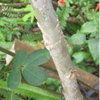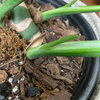piper nigrum
dustin_nevadanorth
16 years ago
More Discussions
A few years back I got two piper nigrum, (black pepper) plants from two different trades. They look similar but have some differences. Both have the same general look, leafs look same, both produce rubbery balls on the back of the leaf. The stick next to the plants is a one foot ruler for reference.
Plant one grows faster, branches without pinching, has smaller leafs and stems (1/8 inch). When the soil dries it starts growing were it left off. Never suckers.
Plant two has larger leaf and stems (1/4 inch), grows slower, when dried out the current growth stops. Upon rewatering it sends out new suckers and never branches at the stem. Since I sometimes forget to keep it wet and we live in the high and dry desert it does not grow so well.
These plants may not be the same plant piper nigrum, if so I would like to id what they are.
http://img.photobucket.com/albums/v258/DustinFreeman1/piper1c.jpg
http://img.photobucket.com/albums/v258/DustinFreeman1/piper1b.jpg The box is above what may be a flower bud, not sure. It grows about inch long just after a leaf forms then dries up. Maybe too dry here.
http://img.photobucket.com/albums/v258/DustinFreeman1/piperflower.jpg blow up of flower?
http://img.photobucket.com/albums/v258/DustinFreeman1/piper1b.jpg
http://img.photobucket.com/albums/v258/DustinFreeman1/piper1a.jpg
http://img.photobucket.com/albums/v258/DustinFreeman1/piper2a.jpg
If you are unable to help can you recommend sources for information? Also can you recommend sites that will have detailed information on growing this plant? I have had a hard time finding much that is not geared towards cooking with pepper. If there is anything I missed let me know. Thanks for looking.
Dustin


karyn1
orchidguyftl
Related Professionals
Derry Landscape Architects & Landscape Designers · West Milford Landscape Architects & Landscape Designers · Windham Landscape Architects & Landscape Designers · Forest Acres Landscape Architects & Landscape Designers · Montgomeryville Landscape Architects & Landscape Designers · Suffern Landscape Architects & Landscape Designers · Washington Landscape Architects & Landscape Designers · Caldwell Landscape Contractors · Canyon Lake Landscape Contractors · Crystal Landscape Contractors · Las Vegas Landscape Contractors · Mason Landscape Contractors · Natick Landscape Contractors · Wallingford Landscape Contractors · West Haverstraw Landscape Contractorsdustin_nevadanorthOriginal Author
costaricafinca
orchidguyftl
costaricafinca
Heathen1
dustin_nevadanorthOriginal Author
orchidguyftl